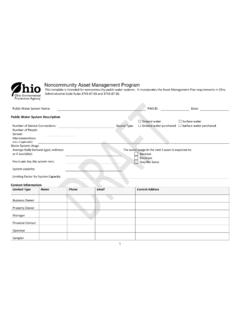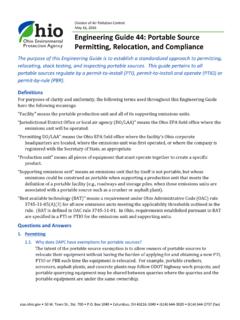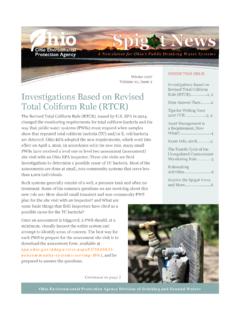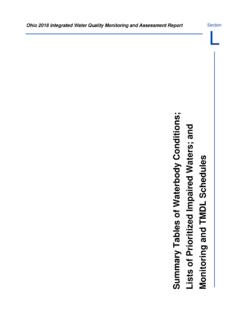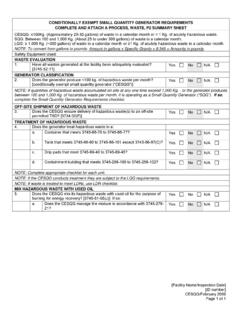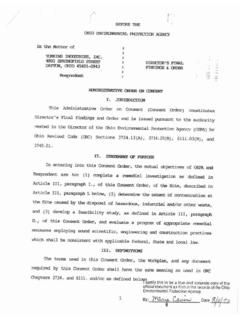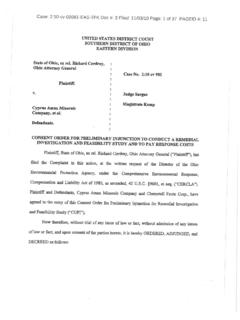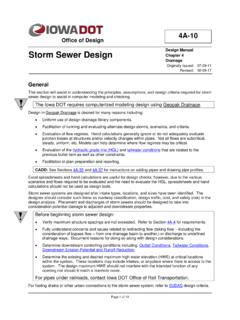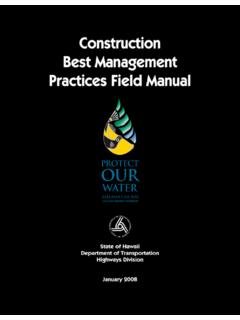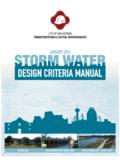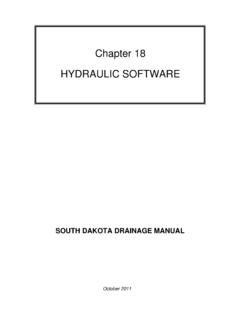Transcription of Rainwater and Land Development: Ohio's Standards for ...
1 chapter 6. Sediment Controls Sediment control is the compromise phasing, construction, and rapid stabiliza- between protecting water resources and tion with the most effective sediment con- accomplishing work during grading and trol practices that can be used on their site. construction activities. Construction activi- Sediment controls have limited effective- ties are often fully underway when Ohio's ness even when installed well and operat- most intense storms happen, yielding ing at their best. And this is often not the significantly greater amounts of mud or case. For this reason, the design, installa- sediment than other land disturbing activi- tion and maintenance of sediment control ties such as agricultural crop production.
2 Practices are critical for them to function Eventually disturbed soils will be stabi- properly. lized with new vegetation, landscaping and buildings, but in the interim practices that are effective in capturing sediment are needed to prevent tons of soil from mov- ing offsite and into wetlands, ponds, lakes, creeks and rivers. Sediment controls are a compromise, because they don't capture all sediment. They capture the largest soil particles, (sands and large silts), but are not very effective with smaller silts and clay Sediment particles. Additionally, not all practices Sediment are equally effective.
3 Settling ponds may be greater than 50 or 60 percent effective Silt while the other practices (like inlet protec- Storm Drain Inlet tion or silt fence) are frequently much less Filter than 50 percent effective. Effectiveness Filter also depends on the size of eroded par- ticles entering the pond. For example, if suspended particles are fine silts and clays, then effectiveness of capture descreases. Conversely, if eroded particles are large silts and sands, then effectiveness will increase with the same pond design. Thus site designers must combine a strategy of chapter 6 Sediment Controls 1.
4 Sediment Basin Description A sediment basin is a temporary settling pond that releases runoff at a controlled rate. The basin is designed to slowly release runoff, detaining it long enough to allow most of the sediment to settle. Sediment basins typically consist of a dam or embankment, the pool area for water and sediment storage, principal and emergency spillways, and a controlled dewatering device or skimmer. Secondary benefits include runoff control and preserving the capacity of downstream reservoirs, ditches, canals, diversions, waterways and streams. The entire structure may be removed when construction is complete and the drainage area is stabilized or may be converted to a detention basin for post-construction storm water management.
5 Condition Where Practice Applies Sediment basins under these guidelines are limited to sites where: Failure of the structure would not result in loss of life, damage to homes or buildings, or interruption of use or service from private utilities. The drainage area is 100 ac. or less. The height of the dam is 25 ft. or less, as measured from the natural streambed at the downstream toe of the dam to the top of the dam. The basin is to be removed within 36 months after its construction. Sediment basins exceeding any of these limits shall conform to Ohio Dam Safety Laws, local requirements, or Natural Resources Conservation Service Standards and Specifications No.
6 378 for ponds and No. 350 for sediment basins, whichever is most restrictive. 2 chapter 6 Sediment Controls Ohio Dam Safety Laws may apply to basins larger than 15 (24,000 cy) as mea- sured to the top of the dam. Information is available from the Ohio Department of Natural Resources, Division of Water, 2045 Morse Road, Bldg. E-2, Columbus, Ohio 43229-6605;. phone (614) 265-6731. Planning Considerations Sediment basins and sediment traps are generally accepted methods for treating sediment- laden runoff. Sediment basins and traps are usually placed near the perimeter of construc- tion-sites to prevent off-site sedimentation.
7 Construction activity should be phased to allow them to remain functional for as long as possible, ideally until the area contributing runoff is stabilized with dense permanent vegetation. Settling ponds, both traps and basins, are generally recommended as the principal sediment-control practices for construction-sites. The typical components of a settling basin are shown in Figure on the following page. Effectiveness Sediment basins do not trap all the sediment that washes into them. Sediment basins are not as effective in controlling fine particles ( , silt, clay) as sand and other coarse particles.
8 Therefore, sediment basins as with all sediment controls should be used in conjunction with erosion control practices such as temporary seeding to reduce the total amount of sediment washing into them. Soil analysis may be necessary to determine whether a sediment basin will be a feasible means of preventing off-site sedimentation. Timing Sediment basins, along with other sediment-control practices, must be con- structed as a first step in any land disturbing activity and must be functional before upslope land disturbance takes place. Construction Phases Sediment basins should be placed so they function through all phases of the site's development, both before and after new drainage systems are con- structed.
9 Location It is practical and economical to locate sediment basins where the largest stor- age capacity can be obtained with the least amount of earthwork, such as depressions and drainage ways (without a defined bed or bank). Do not place sediment basins in or immedi- ately adjacent to wetlands or stream channels. Diverting Runoff Temporary diversions at the perimeter of construction sites are used to direct runoff to sediment basins. Below Storm Drains Sediment basins may be placed beyond the ends of proposed storm-drain systems. Postponing construction of the last sections of the storm drain may be necessary to provide adequate area for the sediment basin between the outlet and receiving watercourse.
10 Storm Drain Diversions Storm drains may also be temporarily redirected through sedi- ment basins during construction (Figure ). Utilities Give special consideration to sediment basin location and potential interference with construction of proposed drainage ways, utilities and storm drains. chapter 6 Sediment Controls 3. (Not to Scale). Figure Temporary storm drain diversion Design Criteria For the purposes of this manual the design of a sediment basin is broken down into five parts which include: 1) Pool Design 2) Embankment Design 3) Dewatering Design 4) Principal Spillway Design 5) Emergency Spillway Design.

